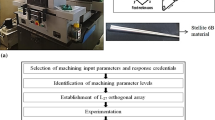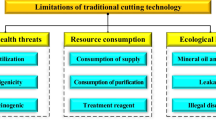Abstract
The mathematical model of the useful flow and flow rate of grinding fluid under casting surface grinding condition has been established. A detailed assessment of the improvement in the useful flow rate of grinding fluid, which optimizes the grinding fluid supply, has been published in the International Journal of Advanced Manufacturing Technology (Modeling and simulation of useful fluid flow rate in grinding; 2014, 75 (9-12):1587-1604). However, the experiment has not been further verified. In this paper, the useful flow and flow rate of grinding fluid under casting surface grinding condition were extensively studied through experimentation. A collection device for the useful flow of grinding fluid was designed. Moreover, the influence of the speed of the grinding wheel, grinding fluid jet velocity, particle size, and bulk porosity on useful flow and useful flow rate was analyzed. Results show that experimental and simulation results differ slightly under certain grinding parameters. This difference is mainly due to the different peripheral velocities of the grinding wheel and grinding fluid jet velocities. The effect of the gas barrier layer causes the grinding fluid to penetrate the surface pore, which has different coefficients. Meanwhile, the filling coefficient is 0.5 in the simulation settings. A large filling coefficient results in a high useful flow rate. When the grinding fluid jet velocity is increased, the capability to overcome the gas barrier layer is strengthened. Thus, the filling coefficient becomes large. When the speed of the grinding wheel is low, the gas barrier layer is weak. Hence, the filling coefficient is relatively high. The distribution of the simulation results is in agreement with that of the experimental results. This condition verifies the accuracy of the mathematical model and simulation analysis of the useful flow rate of grinding fluid.
Similar content being viewed by others
References
Li CH, Zhang XW, Zhang Q, Wang S, Zhang DK, Jia DZ, Zhang YB (2014) Modeling and simulation of useful fluid flow rate in grinding. Int J Adv Manuf Technol 75(9–12):1587–1604
Jin T, Cai GQ (2001) Analytical thermal models of oblique moving heat source plane for deep grinding and cutting. J Manufact Sci Eng-ASME 123(1):185–190
Malkin S, Guo C (2007) Thermal analysis of grinding. CIRP Ann Manuf Technol 56(2):760–782
Brinksmeier E, Aurich JC, Govekar E (2006) Advances in modeling and simulation of grinding processes. CIRP Ann Manuf Technol 55(2):667–697
Ebbrell S, Woolley NH, Tridimas YD, Allanson DR, Rowe WB (2000) The effects of cutting fluid application methods on the grinding process. Int J Mach Tools Manuf 40(2):209–223
Bo Z, Akira N (2000) Hydrodynamic fluid pressure in grinding zone during grinding with metal-bonded diamond wheels. J Tribol 122(3):603–608
Frank C, Wojciech Z, Edwin F (2004) Fluid performance study for groove grinding a nickel-based superalloy using electroplated cubic boron nitride (CBN) grinding wheels. J Manuf Sci Eng 126(3):451–458
Gao Y, Tse S, Mak H (2003) An active coolant cooling system for applications in surface grinding. Appl Therm Eng 23(5):523–537
Gviniashvili V, Webster J, Rowe B (2005) Fluid flow and pressure in the grinding wheel-workpiece interface. Trans ASME 127(1):198–205
Morgan MN, Jackson AR, Wu H et al (2008) Optimisation of fluid application in grinding. CIRP Annals-Manuf Technol 57(1):363–366
Baheti U, Guo C, Malkin S (1998) Environmentally conscious cooling and lubrication for grinding. Proceedings of the International Seminar on Improving Machine Tool Performance: 643–654
Weinert K, Inasaki I, Sutherland JW (2004) Dry machining and minimum quantity lubrication. Annals CIRP 53(2):323–349
Donaldson K, Li XY, MacNee W (1998) Ultrafine (nanometer) particle mediated lung injury. J Aerosol Sci 29(5):553–560
Park K-H, Olortegui-Yume J, Yoon M-C (2010) A study on droplets and their distribution for minimum quantity lubrication (MQL). Int J Mach Tool Manuf 50(9):824–833
Sheng W, Changhe L, Dongkun Z, Dongzhou J, Yanbin Z (2014) Modeling the operation of a common grinding wheel with nanoparticle jet flow minimal quantity lubrication. Int J Adv Manuf Technol 74(5–8):835–850
Campbell JD (1993) An investigation of the grinding fluid film boiling limitation. Technical papers-society of manufacturing engineers-all series
Campbell JD (1995) Optimized coolant application. Technical papers- society of manufacturing engineers-all series
Ganesan M, Guo C, Malkin S (1995). Measurement of hydrodynamic forces in grinding. Transactions-north American manufacturing research institution of SME: 103–108
Ganesan M, Guo C, Ronen A (1996) Analysis of hydrodynamic forces in grinding. Transactions-north American manufacturing research institution of SME: 105–110
Chang CC, Wang SH, Szeri AZ (1996) On the mechanism of fluid transport across the grinding zone. J Mech Des 118(3):332–338
Klocke F, Baus A, Beck T (2000) Coolant induced forces in CBN high speed grinding with shoe nozzles. CIRP Annals-Manuf Technol 49(1):241–244
Hryniewicz P, Szeri AZ, Jahanmir S (2001) Application of lubrication theory to fluid flow in grinding: Part I—flow between smooth surfaces. J Tribol 123(1):94–100
Hryniewicz P, Szeri AZ, Jahanmir S (2001) Application of lubrication theory to fluid flow in grinding: Part II—influence of wheel and workpiece roughness. J Tribol 123(1):101–107
Guo C, Malkin S (1992) Analysis of fluid flow through the grinding zone. J Eng Ind ASME 114(2):427–434
Engineer F, Guo C, Malkin S (1992) Experimental measurement of fluid flow through the grinding zone. J Eng Ind 114(4):61–66
Gviniashvili V, Webster J, Rowe B (2005) Fluid flow and pressure in the grinding wheel-workpiece interface. J Manuf Sci Eng 127(1):198–205
Gviniashvili V, Rowe WB, Morgan MN (2004) Useful flowrate based on grinding power. J Key Eng Mater 257–258:333–338
Gviniashvili VK, Woolley NH, Rowe WB (2004) Useful coolant flowrate in grinding. Int J Mach Tools Manuf 44(2):629–636
Li CH, Hou YL, Fang Z (2011) Analytical and experimental investigation of grinding fluid hydrodynamic pressure at wedge-shaped zone. Int J Abras Technol 4(2):140–155
Li C, Hou Y, Xiu S, Cai G (2008) Model and simulation of slurry velocity and hydrodynamic pressure in abrasive Jet finishing with grinding wheel as restraint. Key Eng Mater 375–376:449–453
Chang-he L, Guang-qi C, Shi-chao X (2007) Hydrodynamic pressure modeling and verification of contact zone on abrasive jet finishing with grinding wheel as restraint. Acta Armamentarii 28(2):202–205
Han ZL, Li CH (2013) Theoretical modeling and simulation of airflow field near grinding wheel. Int J Control Autom 6(4):145–155
Li CH, Han ZL (2013) Modeling and simulation of the airflow field in wedge-shaped zone during the high-speed grinding. Int J Abras Technol 6(2):114–131
Junyi Z, Nan L, Zhengfeng J (2009) Application study on two-phase flow field properties of grinding fluidic jet. Mach Tool Hydraul 37(1):20–23
Barczak LM, Batako ADL, Morgan MN (2010) A study of plane surface grinding under minimum quantity lubrication (MQL) conditions. Int J Mach Tools Manuf 50(11):977–985
Ramesh K, Huang H, Yin L (2004) Analytical and experimental investigation of coolant velocity in high speed grinding. Int J Mach Tools Manuf 44(10):1069–1076
Brinksmeier E, Minke E (1993) High-performance surface grinding—the influence of coolant on the abrasive process. Annals CIRP 42(1):367–370
Engineer F, Guo C, Malkin S (1992) Experimental measurement of fluid flow through the grinding zone. ASME Jo Eng Ind 114(1):61–66
Chang CC, Wang SH, Szeri AZ (1996) On the mechanism of fluid transport across the grinding zone. J Manuf Sci Eng-Trans ASME 118(3):332–338
Chang CC, Wang SH, Szeri AZ (1996) On the mechanism of fluid transport across the grinding zone. J Manuf Sci Eng 118(8):332–338
Schumack MR, Jin-Bok C, Schultz WW (1991) Analysis of fluid flow under a gringing wheel. Trans ASME 113(5):190–197
Vladimir G, John W, Brian R (2005) Fluid flow and pressure in the grinding wheel-workpiece interface. Trans ASME 127(2):198–205
Chang CC (1997) An application of lubrication theory to predict useful flow-rate of coolant on grinding porous media. Tribol Int 30(8):575–581
Mao C, Zou H, Huang X, Zhang J, Zhou Z (2013) The influence of spraying parameters on grinding performance for nanofluid minimum quantity lubrication. Int J Adv Manuf Technol 64(9–12):1791–1799
Adibi H, Rezaei SM, Sarhan AAD (2014) Investigation on using high-pressure fluid jet in grinding process for less wheel loaded areas. Int J Adv Manuf Technol 70(9–12):2233–2240
Zhang D, Li C, Zhang Y, Jia D, Zhang X (2015) Experimental research on the energy ratio coefficient and specific grinding energy in nanoparticle jet MQL grinding. Int J Adv Manuf Technol 78(5–8):1275–1288
Li KM, Lin CP (2012) Study on minimum quantity lubrication in micro-grinding. Int J Adv Manuf Technol 62(1–4):99–105
Wang S, Li C, Zhang D, Jia D, Zhang Y (2014) Modeling the operation of a common grinding wheel with nanoparticle jet flow minimal quantity lubrication. Int J Adv Manuf Technol 74(5–8):835–850
Jackson A (2008) An investigation of useful fluid flow in grinding, Ph.D. Thesis, Liverpool John Moores University
Baines-Jones VA (2008) System design for improved useful fluid flow in grinding, Ph.D. Thesis, Liverpool John Moores University
Morgan MN, Jackson AR, Wu H, Baines-Jones V, Batako A, Rowe WB (2008) Optimisation of fluid application in grinding. CIRP Annals-Manuf Technol 57(1):363–366
Morgan MN, Barczak L, Batako A (2012) Temperatures in fine grinding with minimum quantity lubrication (MQL). Int J Adv Manuf Technol 60(9–12):951–958
Morgan MN, Cai R, Guidotti A, Allanson DR, Moruzzi JL, Rowe W (2007) Design and implementation of an intelligent grinding assistant system. Int J Abras Technol 1(1):106–135
Heinemann R, Hinduja S, Barrow G, Petuelli G (2006) Effect of MQL on the tool life of small twist drills in deep-hole drilling. Int J Mach Tools Manuf 46(1):1–6
Author information
Authors and Affiliations
Corresponding author
Rights and permissions
About this article
Cite this article
Li, C., Zhang, Q., Wang, S. et al. Useful fluid flow and flow rate in grinding: an experimental verification. Int J Adv Manuf Technol 81, 785–794 (2015). https://doi.org/10.1007/s00170-015-7230-z
Received:
Accepted:
Published:
Issue Date:
DOI: https://doi.org/10.1007/s00170-015-7230-z




